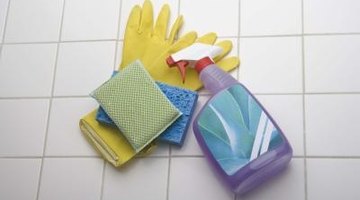Can You Mix Ammonium Hydroxide with Bleach?
Chlorine bleaches are common household chemicals containing dissolved sodium hypochlorite. Ammonia, another common cleaning chemical, is a gas that dissolves readily in water to yield ammonium hydroxide -- the ammonia you buy at the supermarket. Familiarity with these chemicals might lull you into thinking they work well together, but don't be fooled. Mixing ammonia and bleach can make poisonous gases -- some of them strong enough to kill you.
Characteristics

Sodium hypochlorite is an ionic compound with the formula NaOCl; when it dissolves, it separates into sodium ions and hypochlorite ions (OCl-). Both ammonia and the hypochlorite ion are bases, meaning they can pick up hydrogen ions, decreasing the hydrogen ion concentration and making the solution more basic. This property makes them useful in cleaning, but it doesn't mean you should mix them together, because in combination, these two chemicals can undergo other reactions.
Chloramines
The first dangerous reaction that can occur produces chloramines. When NH3 reacts with OCl-, it may form NH2Cl, NHCl2 or NCl3, creating monochloramine, dichloramine or nitrogen trichloride, respectively. All three of these compounds are toxic; nitrogen trichloride is even more hazardous because it is potentially explosive when exposed to heat or sunlight. Being poisoned or blown up isn't fun, and you definitely don't want this kind of chemical reaction occurring in your toilet bowl.
Other Products
Mixing ammonia and bleach can also produce chlorine, a green diatomic gas used as a chemical warfare agent during the First World War. This is not something you want to inhale. The dichloramine can also react with ammonia to create an explosive compound called hydrazine; this compound is sometimes used in rocket fuel, but it's not something you want to have around in your shower or bathtub. Which products you get from these reactions depends on the ratio of ammonia to bleach. If you have more bleach than ammonia, you'll favor the production of chloramines like nitrogen trichloride. More ammonia than bleach, on the other hand, will favor the production of hydrazine.
Considerations
All of the compounds described above are extremely dangerous. You should never mix ammonia and bleach or cleaners containing these compounds. It's also important to avoid mixing bleach with acids, because this reaction can yield chlorine gas. Vinegar and chlorine bleach might sound innocuous, for example, but it's also very unsafe. In general, the best rule is to avoid combining cleaning products like these. Read the directions on the back of the bottle before you use the product.
References
Writer Bio
Based in San Diego, John Brennan has been writing about science and the environment since 2006. His articles have appeared in "Plenty," "San Diego Reader," "Santa Barbara Independent" and "East Bay Monthly." Brennan holds a Bachelor of Science in biology from the University of California, San Diego.
Photo Credits
- Jupiterimages/Comstock/Getty Images
More Articles



